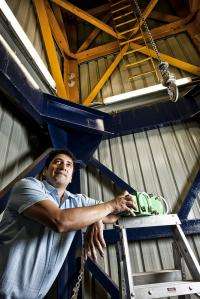To boldly go where no glass has gone before

QUT's first foray into space is bound to be a giant step for mankind. Dr Martin Castillo from Queensland University of Technology's (QUT) Science and Engineering Faculty, and researcher for the university's micro-gravity tower facility, has partnered with the United States Air Force to fund world-first research into the development of ZBLAN glass.
Dr Castillo said the special glass will be the first QUT project to be launched into space.
"True ZBLAN glass fibres can only be made in the absence of gravity," he said.
"This glass contains a variety of heavy metals that upon cooling create internal stresses which leads to crystallization of the material, an undesired property for glass.
"The synthesis of this material in the absence of gravity has the ability to overcome this barrier."
It is believed the glass could revolutionise the way we make fibres for telecommunications and medical imaging tools.
Dr Castillo said the glass has the lowest theoretical attenuation loss of any glass yet known to man, which means little or no loss in signal occurs within the material.
"This special glass can be potentially drawn into a solid fibre and signals would be able to be transmitted over much great distances than in current silicate glass fibres," he said.
"The result of this is potentially eliminating power consuming amplifiers and repeaters while significantly increasing bandwidth.
"Although this glass has been made in a few places, no one has yet figured out how to draw it into a fibre."
Research will first be conducted at QUT's micro-gravity tower in an experiment that will see the glass undergo ~2.1 seconds of microgravity over a 21.3 meter drop inside a drag shield.
Dr Castillo, who has previously worked for space programs in the United States and Japan, will then board NASA's parabolic flight plane, dubbed the 'vomit comet', before launching the project into space via a United States Air Force suborbital satellite by mid next year.
"In order to stay at the leading edge of the synthesis of specialised glass, all traditional methods have to be abandoned," Dr Castillo said.
"I previously spent two years working in Japan trying to produce this glass via gas levitation and with a fibre pulling apparatus in zero gravity and was unsuccessful.
"Now I think we've been able to formulate very new and different techniques to that used by anyone in the world."
Provided by Queensland University of Technology


















